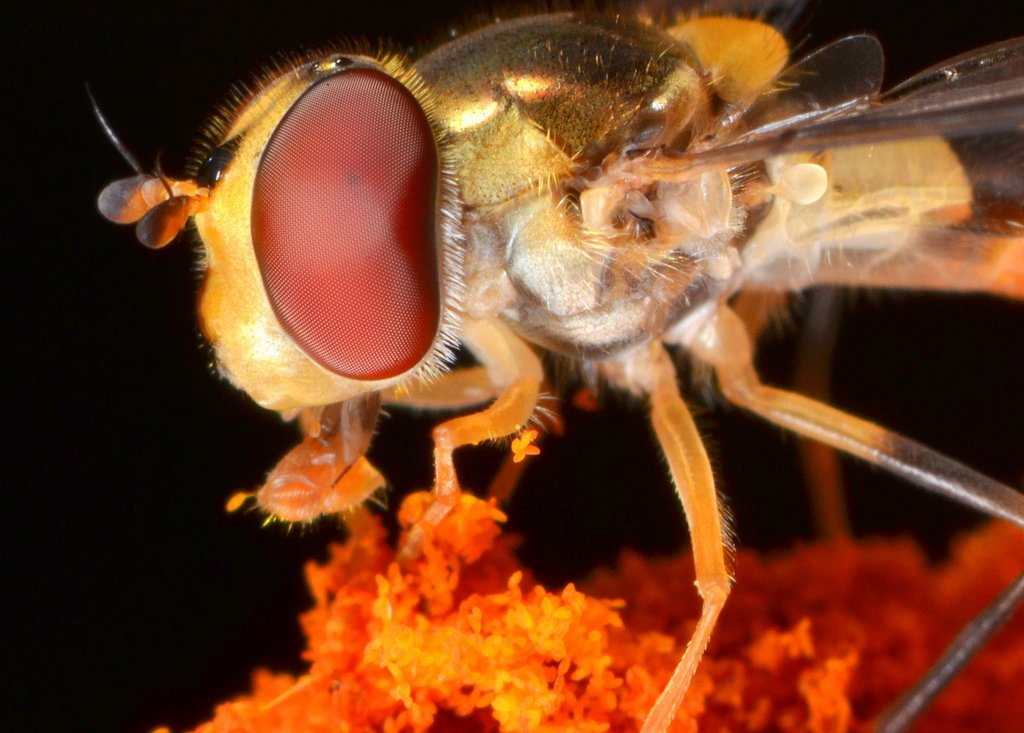
15
2012Macro Magic
Shot of the Month – November 2012
Fear not, we are not under attack from giant mutant killer bees.
This lil fella, a Hoverfly, is actually less than an inch in length and quite harmless.
There are over 6,000 species of hoverflies around the world and not a single one will harm you.
Most hoverflies look like more dangerous wasps and bees but this is simply a ploy to look threatening and hopefully scare off potential predators.
Gardeners in the know dig hoverflies because they prey on pest insects like aphids and leafhoppers. Savvy growers will cultivate plants that attract hoverflies so they can naturally deal with pests and promote natural pollination.
This extreme close-up (the hoverfly is sitting on the stamen of a flower in our garden and those orange blobs are individual grains of pollen!) is an example of macro photography. What is macro photography? The answer to this takes us down a rabbit hole to a confusing, complex world that can involve all sorts of physics and geeky science. How to shoot such shots equally leads us into a world with a bewildering array of equipment options and solutions. Just a quick tour to give you a sense of it all.
Macro photography, for most of us, simply means close-up photography, usually of small stuff. The end result is an image where the subject appears at least life-size (one inch equals one inch) and often the subject appears greater than life-size, as with this photo.
Do you need fancy equipment to do close-up photography? No. Yes. Well, it depends. You can probably start taking macro shots today if you have a digital point-and-shoot (PaS) camera. Ever notice that little flower icon on your camera?
That setting puts your camera in “macro” mode. The small sensors of PaS cameras allow for some good macro shooting (I’ll spare you the science on why this is the case). If you want more professional results use a DSLR. From here the options are nearly endless.
You can use a “normal” lens and attach diopters in front which are basically magnifiers. You can put a normal lens on backwards (with an adapter) and voila, you have a macro lens. Or you can attach extension tubs to your normal lens which moves it further from the body and allows you to get closer to your subject (which makes it appear bigger). Or you can buy a true “macro” lens which has been designed specifically to give excellent image quality for close-up photography. For stationary subjects, like flowers, you will want to use a tripod. For insects, you will want to use a flash to freeze the action.
For more on the science and equipment options look here, and here.
You can spend a lot or a little. Either way, you can get some very nice shots if you work at it.
One of the biggest challenges in macro photography is the minuscule depth of field. The closer you get (the more magnified the subject) the shallower the depth of field. This means that if you focus on the eye of a bee, his nose could be out of focus! You normally want to set the camera on manual focus and adjust the lens to its minimum focus distance. Then you physically move in until the subject comes into focus. From here, rock back and forth and shoot away when you see the element you want clearly. This can be brutally tiring as the slightest drift can cause you to miss the shot. And it is especially hard with insects and other moving critters. You may need to shoot dozens, and perhaps hundreds of images till you get one where it all comes together. One technique to get around this problem is to shoot multiple images where different parts of the subject are in focus. You can then use software to merge these images and the final result is a photo where much more of the subject appears sharp. This technique is called focus stacking. This is best accomplished with a tripod as the images must be identical so they overlap properly. Hand-held stacking is possible, but you need to be be a Jedi master with an incredibly steady hand to pull it off.
One such macro master is Thomas Shahan. Check out his site for some of the most amazing insect photography I have ever seen.
Thomas also made a great video on macro photography. I have watched it a half dozen times. His Zen-like narration is ultra soothing and the images are spectacular.
The great thing about macro photography is that you need not go far to find compelling subjects. Walk outside and you can spend hours within a few square feet shooting an astonishing array of flora and fauna. Even around your house, the most mundane object can suddenly become a work of art once you find the right scale and angle.
Let the Lilliputian adventures begin…..

